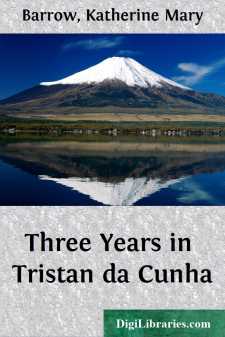Categories
- Antiques & Collectibles 13
- Architecture 36
- Art 48
- Bibles 22
- Biography & Autobiography 813
- Body, Mind & Spirit 142
- Business & Economics 28
- Children's Books 15
- Children's Fiction 12
- Computers 4
- Cooking 94
- Crafts & Hobbies 4
- Drama 346
- Education 46
- Family & Relationships 57
- Fiction 11828
- Games 19
- Gardening 17
- Health & Fitness 34
- History 1377
- House & Home 1
- Humor 147
- Juvenile Fiction 1873
- Juvenile Nonfiction 202
- Language Arts & Disciplines 88
- Law 16
- Literary Collections 686
- Literary Criticism 179
- Mathematics 13
- Medical 41
- Music 40
- Nature 179
- Non-Classifiable 1768
- Performing Arts 7
- Periodicals 1453
- Philosophy 64
- Photography 2
- Poetry 896
- Political Science 203
- Psychology 42
- Reference 154
- Religion 513
- Science 126
- Self-Help 84
- Social Science 81
- Sports & Recreation 34
- Study Aids 3
- Technology & Engineering 59
- Transportation 23
- Travel 463
- True Crime 29
Three Years in Tristan da Cunha
Description:
Excerpt
CHAPTER I
Tristan da Cunha, a British possession, is an island-mountain of volcanic origin in the South Atlantic ocean. Latitude 37° 5' 50" S.; longitude 12° 16' 40" W. Circular in form. Circumference about 21 miles. Diameter about 7 miles. Height 7,640 feet. Volcano extinct during historic times. Discovered by the Portuguese navigator Tristan da Cunha, 1506. Occupied by the British, 1816. Nearest inhabited land, the island of St. Helena, 1,200 miles to the N.
In the autumn of 1904 we saw in the Standard a letter which arrested our attention. It was an appeal for some one to go to the Island of Tristan da Cunha, as the people had had no clergyman for seventeen years.
Now, Tristan da Cunha was not an unknown name to us, for as a child my husband loved to hear his mother tell of her shipwreck on Inaccessible, an uninhabited island twenty-five miles south-west of Tristan da Cunha.
She, then a child of four, and her nurse were passengers on the Blendon Hall, which left London for India in May 1821, and was wrecked during a dense fog on Inaccessible, July 23. The passengers and crew drifted ashore on spars and fragments of the vessel. Two of the crew perished, and nearly all the stores were lost. For four months they lived on this desolate island. A tent made out of sails was erected on the shore to protect the women and children from the cold and rain. They lived almost entirely on the eggs of sea-birds.
After waiting some time in hope of being seen by a ship, they made a raft from the remains of the wreck, and eight of the crew set off in it to try to reach Tristan, but were never heard of again, poor fellows. A few weeks later a second and successful attempt was made. The men reached Tristan, but in a very exhausted state. Then the Tristanites, led by Corporal Glass, manned their boats, and at great personal risk succeeded in fetching off the rest of the crew and passengers, who remained on Tristan till January 9, 1822, on which day a passing English brig took them to the Cape of Good Hope.
This was eighty-four years ago. And now the son of that little shipwrecked girl was seriously thinking of going out to minister to the children of her rescuers. Here I may mention that in the whole of their history, from 1816 to 1906, they had had only two clergymen living amongst them.
The first to go out was the Rev. W. F. Taylor, under the S.P.G. in 1851, a young London warehouseman who had not long been ordained. It is related by one of the passengers of the ship in which Mr. Taylor was sailing that the master of the vessel had great difficulty in locating the island, and that for three days they cruised about and saw nothing resembling land. The third day towards evening the skipper gave up the search and headed for the Cape. Mr. Taylor, who was gazing towards the setting sun suddenly saw the Peak of Tristan, which is 7,640 feet high, emerge out of the clouds. It was about ninety miles away. The captain turned back, and his passenger was safely landed. Mr. Taylor stayed there some five years....


